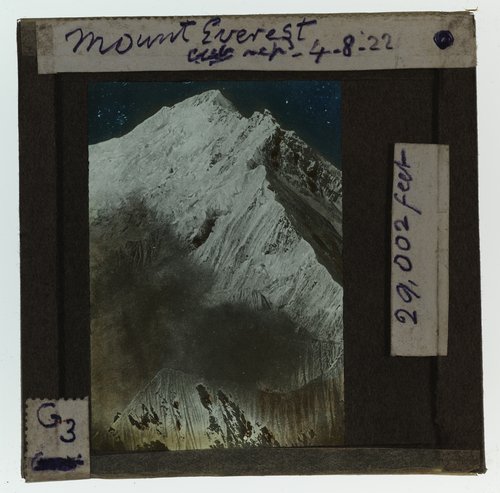
70 years ago today, Edmund Hillary of New Zealand and Tenzing Norgay of Nepal became the first two people confirmed to have reached the summit of Mount Everest (Sagarmatha / Chomolungma).
It was a great achievement – by 1953 people had been trying for decades to climb Everest, the world’s highest and arguably most dangerous mountain. At least ten previous expeditions to the mountain had been forced to turn back or met with disaster. The most famous casualties were probably British climbers George Mallory and Alexander Irvine, who both died in a fall near the summit in 1924. It’s still unclear whether they made it to the top before the accident happened.

Peak of Mount Everest with starry sky visible above
Lantern slide by Clement Lindley Wragge taken in or before 1922. Courtesy of Auckland Museum, reference number PH-1984-1-LS78-3-39.
Climbing Everest was so difficult that another 29 years would pass between Mallory’s death and Hillary’s successful ascent in 1953. A whole 75 years passed before Mallory’s body was found in 1999 (Irvine’s is still missing, although his ice axe was found in the 1930s). To some observers it looked like climbing all the way to the summit of Everest might be physically impossible. But mountaineers kept trying anyway, and on 29 May 1953, at about 11.30am, Hillary and Tenzing finally reached the top. They spent only 15 minutes taking photos before hurrying back to camp, conscious that their oxygen tanks were running down.

PRESS, VOLUME LXXXIX, ISSUE 27059, 6 JUNE 1953, PAGE 4
Local businesses were keen to link their products to Hillary, even if it was a stretch. This ad was for a Christchurch grain merchant. Courtesy Papers Past.
It took a few days for news of the successful climb to be relayed out of Nepal and into the international media. By chance, it coincided with another big news story preoccupying New Zealanders and other British subjects – the coronation of Queen Elizabeth II on 2 June. The two events are often mentioned in tandem in newspapers and broadcasts of the time, and some commentators went so far as to describe the climb as a coronation gift for the Queen.

PRESS, VOLUME LXXXIX, ISSUE 27057, 4 JUNE 1953, PAGE 8
New Zealanders in London to watch the coronation are reported to have performed a haka in celebration when the news broke. Courtesy Papers Past.
Having set out on the expedition with a low public profile, Hillary returned to New Zealand as an international celebrity and a Knight Commander of the British Empire. In some interviews he later expressed discomfort with the enormous amount of praise he received, which he felt was out of proportion to what he’d actually done. You can hear an example of this from about the seven-minute mark in this recording, where he dismisses Everest as “a great chunk of a mountain, rather ugly really as mountains go,” and expresses a desire to keep adventuring, rather than resting on his laurels.

Photo by Sandy Ditchburn, Ngā Taonga Sound & Vision
This visitor book from Wellington radio station 2YA was signed by Sir Edmund Hillary when he arrived to give an interview about three months after the climb.
The Archive holds over 700 recordings of and about Edmund Hillary, including decades of newsreels, documentaries, and radio interviews. We’ve highlighted a few favourites below; use the online catalogue to explore all holdings.
This film of life on the 1953 expedition was shot and later deposited by Sir Edmund Hillary. It’s an amazing first-person view of how harsh and treacherous conditions were for everyone on the mountain. Content warning: depicts severe frostbite and injuries.
At the start of this recording Acting Prime Minister Keith Holyoake announces to a live audience that Hillary’s climb has been successful. After two rounds of applause the subject changes to the coronation, which took place that day in London.
In this short actuality we see Hillary and fellow mountaineer George Lowe arrive back in New Zealand by flying boat, where they are welcomed by family members and press.
In 1971 Tenzing Norgay and his wife were welcomed to Auckland with a pōwhiri. Part of the event was broadcast on radio in a programme introduced by Selwyn Muru.
30 years after the first ascent, Spectrum produced a radio documentary about its subsequent effects on the Himalayas, good and bad. Includes archival clips of Hillary describing his experiences and how he tried to use his fame to help Sherpa villages.
This 1989 television documentary provides a retrospective of Sir Ed’s life to date.
Hero image: Edmund Hillary and Tenzing Norgay beside aircraft shaking hands in greeting or farewell. Courtesy of Horowhenua Historical Society Inc.